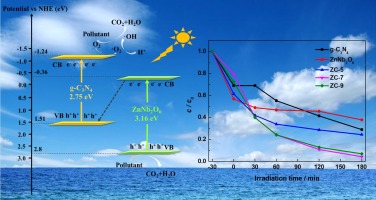崔世海副教授课题组在MATERIALS RESEARCH BULLETIN发表研究论文
Synthesis of Z-Scheme heterojunction ZnNb2O6/g-C3N4 nanocomposite as a high efficient photo-catalyst for the degradation of 2,4-DCP under simulated sunlight
Gu, XY (Gu, Xinyue)[ 1 ] ; Mei, J (Mei, Jie)[ 2 ] ; Lai, JH (Lai, Jiahao)[ 1 ] ; Lv, SY (Lv, Siying)[ 1 ] ; Yang, J (Yang, Jing)[ 1 ]*(杨静); Cui, SH (Cui, Shihai)[ 1 ]*(崔世海); Chen, S (Chen, Sen)[ 3 ]*
[ 1 ] Nanjing Normal Univ, Jiangsu Collaborat Innovat Ctr Biomed Funct Mat, Jiangsu Prov Key Lab Mat Cycling & Pollut Control, Coll Chem & Mat Sci,Jiangsu Key Lab Biomed Mat, 1 Wenyuan Rd, Nanjing 210023, Peoples R China
[ 2 ] Nanjing Normal Univ, Taizhou Coll, Nanjing 225300, Peoples R China
[ 3 ] Nanjing Res Acad Environm Sci, 175 Huju Rd, Nanjing 210013, Peoples R China
MATERIALS RESEARCH BULLETIN,202010,130,110939
In view of the deterioration of the environment and the shortage of resources, it is necessary to develop efficient photocatalysts for the degradation of organic pollutants. Herein, a novel and environmentally friendly ZnNb2O6/g-C3N4 heterojunction nanocomposite was synthesized by calcination-hydrothermal method successfully. The chemical and physical capabilities of the material were characterized by various kinds of analytical instruments. Compared with ZnNb2O6 and g-C3N4, ZnNb2O6/g-C3N4 showed the strongest photocatalytic activity. The nanomaterial was used in the removal of the pollutant 2,4-DCP. The effects of degradation conditions were discussed including component ratio, material dosage, initial analyze concentration, pH and salinity. After 180 min' simulated sunlight illumination, the removal efficiency of 2,4-DCP (10 mg/L) reached 95.7% under the optimum condition. Furthermore, the possible photocatalytic mechanisms were discussed according to four aspects: (i) The conformation of the active species; (ii) The calculation of valence and conduction band; (iii) The analysis Z-scheme heterojunction mechanism; (iv) The speculation of feasible photocatalytic paths. In conclusion, the ZnNb2O6/g-C3N4 (ZC-7) nanocomposite has the least recombination rate of electron-hole pairs and the highest photocatalytic efficiency.

文章链接:
https://www.sciencedirect.com/science/article/pii/S0025540820306875?via%3Dihub
版权与免责声明:本网页的内容由收集互联网上公开发布的信息整理获得。目的在于传递信息及分享,并不意味着赞同其观点或证实其真实性,也不构成其他建议。仅提供交流平台,不为其版权负责。如涉及侵权,请联系我们及时修改或删除。邮箱:sales@allpeptide.com